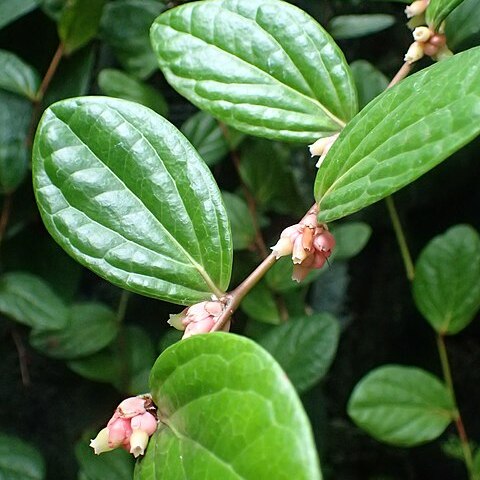above, prominently elevated beneath, the veinlets copiously reticulate and slightly raised on both the surfaces; petioles subterete, flattened above, puberulent, 3-5 mm long, 1.5-2 mm in diameter. Inflorescence axillary, short racemose with usually ca. 4 flowers; rachis subterete basally, 1-2 cm long, basally surrounded by several triangular to oblong bracts 3-5 mm long; pedicels subterete basally but becoming winged distally, striate, glabrous, 1O-20 mm long, each subtended by an oblong bract 3-6 mm long with scattered glandular fimbriae; bracteoles lacking. Flowers glabrous; hypanthium urceolate to obprismatic, ca. 8-9 mm long, the wings ca. 1-1.5 mm wide, the limb subspreading, 8-9 mm long including the lobes; calyx lobes triangular ovate, acute, 5-7 mm long, 4-5 mm wide at the base, ca. 7 parallel, branching veins not quite extending to the margin; corolla white, membranous when dry, 10-14 mm long, ca. 16 mm in diameter at the wid-est point, slightly contracted at both the base and apex and with semiobovate wings 2-5 mm wide, a single longitudinal vein parallel to the margin, the lobes ovate, apiculate, ca. 1 mm wide; stamens 8-10 mm long, the filaments ca. 4 mm long, membranous, connate for about 1/2 their length, adnate to the corolla; anther sacs ca. 2 mm long, gradually tapering into flexible tubules ca. 3 mm long and opening by introrse clefts about ?/-the length of the tubule; stigma truncate.
More
Epiphytic shrub or low tree; mature branches terete, glabrate; immature branches and twigs of new growth terete, puberulous, tan when dry. Leaves oblong or ovate oblong to lance elliptic, 6-13 cm long, 2.5-6 cm wide, basally subcordate, bluntly acuminate, puberulous proximally along the midrib above, glabrous elsewhere, entire, the margin slightly revolute, 5-7-plinerved, the sec-ondary veins originating near the base and the midvein flush or slightly impressed
A shrub. It grows attached to other plants. The branches can be 10 m long.


